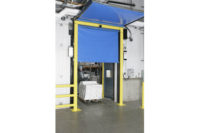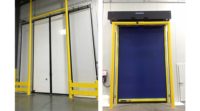Distribution centers, particularly those that are part of the food supply chain, often need to be located in areas with both a high population density and access to sufficient acreage to build warehouse spaces. However, land prices and energy costs, which typically account for 25% of the operating budget, build in high fixed and operating costs.
To keep construction and energy costs more manageable, distribution centers are building taller. For example, Golden State Foods (GSF), Irvine, Calif., built a 158,000-square-foot distribution center in McCook, Ill. This operation, which services more than 460 McDonald’s restaurants throughout Northern Illinois and Northern Indiana, features a two-story, 17,550-square-foot office component, 135,120 square feet of warehouse/distribution space and a cross-dock configuration with a 40-foot clear height. The high ceilings reduces GSF’s building footprint by 25%, allowing for significant up-front and long-term savings on land and energy costs.
Because most heat gain occurs through the roof, a smaller footprint means reduced energy loss for the warehouse.
Of course, a higher ceiling puts unique demands on an operation though. These are addressed by using high-speed doors that enable cold room access, and are capable of opening at a speed of 60-100 inches per second.
Here are three ways high-speed doors maximize the benefits of high ceilings:
Downtime. When it comes to doorways, high-ceiling, low-temp rooms have two challenges. The smaller footprint means less linear wall space, so these rooms require minimal doorways.
Just about all low-temp operations such as GSF are regarded as high-throughput distribution (HTD) facilities, rather than providing long-term storage. Downtime can be deadly for these sites.
But, high-mast forklifts requiring 16 feet of clearance can go through these doorways hundreds of times a day. The extreme cold and the high demand to meet short deadlines mean drivers move quickly and a slow-opening door is a target for forklifts. Losing even one doorway from material handling vehicle collisions can severely disable the operation’s tight schedules and strain client relations.
Fast doors make it nearly impossible for forklifts to hit them. The fastest doors can provide a clear doorway in less than two seconds, allowing unimpeded traffic access for even the tightest approaches to the doorway.
In the very rare case the door does get hit, most models feature a breakaway/fast re-set component that puts the door back in operation in just seconds. Consequently, door repair crews seldom have to pay a visit to the facility, except for an occasional tune-up.
Sustainability. Between the freezer room and the chilled dock, there can be around a 40-degree temperature differential. A high doorway typically has about 160 square feet of exposure area. A considerable amount of frozen air can escape the freezer room when these high doors are open.
Low-temp, high-speed doors reduce air infiltration with fabric panels that cover the doorway. Some feature insulated panels that provide additional R-value.
Recent research also has found that the high speed compensates for the doors’ insulation deficiencies. When a door is used more than 55 times a day, a high-speed door starts to save more energy than a standard door. In a busy HTD facility, 55 cycles can occur in the matter of a few hours.
When closed, a high-speed door does an excellent job of sealing the doorway along all four sides of the perimeter. Along the side of the panel, its guides envelop the panel edge to stop energy from escaping the room. Combined with a floor-hugging gasket and brush gaskets along the header, cold air is well contained.
Faster traffic flow. In an HTD operation where low-temp doorways are accessed hundreds of times a day, seconds count. A high-speed door can be opened and accessed in less than five seconds, saving hundreds of accumulated man-hours a year just waiting for the door to open for better utilization of human resources and investment in equipment.
Recent advancements in high-speed doors include the introduction of solid panel doors capable of opening at 125 inches per second. Traditional solid panel doors that lumbered along at a slow speed were appreciated for their heavily insulated panels, but not for being hit routinely by forklifts. Now, low-temp operations can boast both rapid operation and higher R-values; plus the design of these new doors enables them to withstand accidental impact.
Many HTD low-temp operations with tall facilities must choose between using forklifts to move product or investing in an automated storage and retrieval system (AS/RS). AS/RS can be attractive because it is efficient and the facility will not lose energy through the high doors necessary for forklifts. If an operation is hesitant about the major investment in automated systems, high-speed doors do an excellent job of addressing the energy loss concern.




